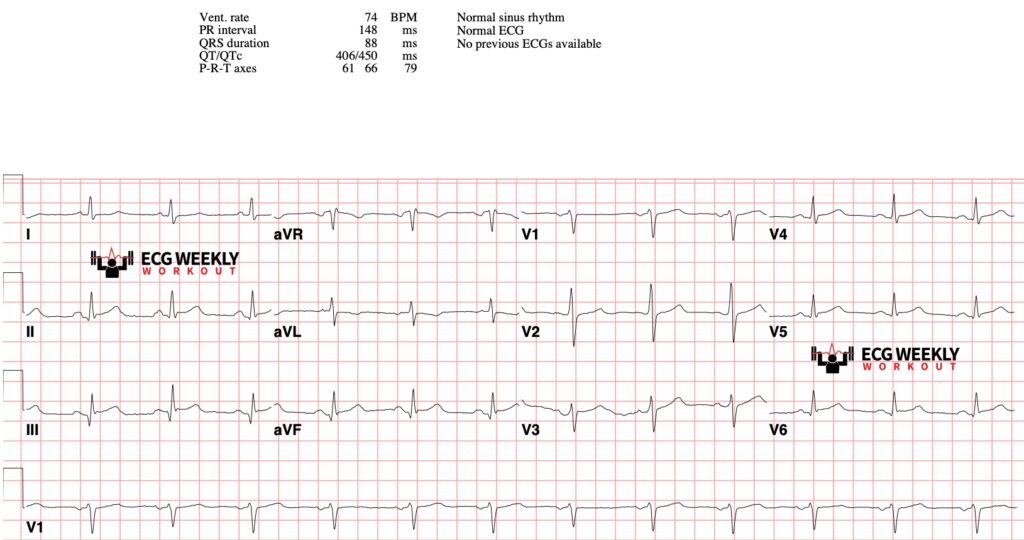
Key Points
- Clinical Context: Abnormal ECGs must be interpreted within the patient’s presentation. Not all abnormalities are life-threatening, and high-risk conditions can still appear subtle or even “normal.”
- Serial Monitoring: Single ECGs are insufficient in many high-risk cases. Repeat ECGs, obtain adjunctive tests, and closely observe evolving symptoms.
- Documentation: Record both abnormal findings and key negatives. Tie findings directly to the presenting complaint and management decisions.
- Customized Interpretation: Tailor your analysis to the clinical scenario (e.g., chest pain, syncope, dyspnea).
- Computer Limitations: Automated interpretation frequently misses early ischemia and subtle abnormalities. Always confirm with your own interpretation.

Abnormal STAT ECG Findings:
Heart Rate:
- Tachycardia (>100 bpm, adults): Distinguish physiologic (fever, pain, hypovolemia) vs. arrhythmic (SVT, VT, AFib).
- Bradycardia (<60 bpm, adults): Consider AV block, medications, ischemia, or electrolyte disorders.
- Pediatrics: Recognize normal age-based heart rate ranges to avoid overcalling abnormality:
- Neonates (0-1 month): 90-180 bpm
- Infants (1 month-1 year): 100-160 bpm
- Toddlers (1-3 years): 90-150 bpm
- Preschoolers (3-5 years): 80-140 bpm
- School-aged (6-12 years): 70-120 bpm
- Adolescents (13-18 years): 60-100 bpm
- QTc abnormalities in children carry similar arrhythmogenic risks as adults.
Rhythm:
- Irregular Rhythms: Consider atrial fibrillation/flutter; crucial to document clearly in stroke evaluations.
- Ectopy: Evaluate significance of premature atrial or ventricular complexes, considering clinical context.
Axis Deviation:
- Left Axis Deviation (LAD): Suggestive of LVH, left anterior fascicular block, or inferior MI.
- Right Axis Deviation (RAD): Indicates right ventricular strain (PE, COPD, pulmonary hypertension), sodium channel blocker toxicity, or hyperkalemia.
Intervals:
- PR Interval:
- Prolonged >200 ms = AV block.
- Short <120 ms = pre-excitation (e.g., WPW).
- QRS Duration:
- Wide (>120 ms): Suggests bundle branch blocks, ventricular rhythms, hyperkalemia, sodium-channel blocker toxicity.
- QTc Interval:
- Prolonged (>500 ms): Significant risk for Torsades de Pointes.
- Short (<350 ms): Risk factor for ventricular arrhythmias and sudden cardiac death.
Waveform Morphology:
- Q Waves: Pathologic if >1 small box wide (≥40 ms) or >1/3 height of R wave, indicating prior MI.
- Poor R Wave Progression: Suggests prior anterior MI or cardiomyopathy.
ST Segment:
- Elevation: OMI/STEMI → emergent reperfusion.
- Depression: Indicates ischemia; clinical correlation required. Depression in V1-V3 may be from Posterior STEMI.
T Waves:
- Inversion: May represent ischemia, especially if dynamic or correlating with symptoms.
- Peaked T Waves: Suggestive of acute hyperkalemia; absence reassuring in ESRD patients.
Common Pitfalls in Abnormal ECG Interpretation:
- Hidden Ischemia: A normal or subtle ECG does not exclude ACS. Repeat if suspicion remains.
- Lead Misplacement:
- High V1/V2 → false anterior MI or RBBB.
- Limb reversal → abnormal axis mimicking pathology.
- Normal Variants:
- Early repolarization (young adults) mimics STEMI.
- Juvenile T-wave inversions (esp. III, aVF, V1–V3 in young females).
- Computer Overreliance: Machines miss early ischemia and subtle findings.
Key Clinical Scenarios & Documentation Examples:
- Chest Pain: “No STEMI/equivalent criteria. No dynamic ischemic changes.”
- Stroke Evaluation: “No atrial fibrillation/flutter present.”
- Dyspnea/PE concern: “No right heart strain (no RAD, S1Q3T3, or T-wave inversion in right precordials).”
- Syncope: “No arrhythmia, AV block, QT prolongation, Brugada pattern, or ischemic changes.”
- ESRD/Hyperkalemia: “T-wave morphology assessed—no peaked T waves, QRS not widened.”
KEY CLINICAL PEARLS:
- A normal ECG does not rule out ischemia or other high-risk pathology.
- Always interpret in clinical context and obtain serial tracings if concern remains.
- Avoid overcalling benign variants but remain vigilant for subtle ischemic changes.
- Careful documentation of both abnormal and absent findings supports sound decision-making and medicolegal protection.
Related Topics & Recommendations:


